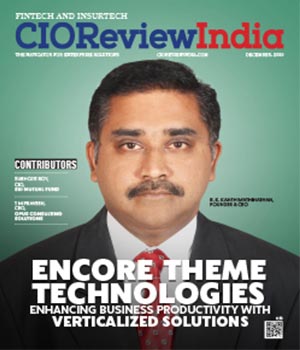
Financial Services Sector Progresses Towards Personalized Solution
Ravi Kethana, Chief Platform Officer, CAMS | Sunday, 14 August 2022, 14:23 IST
 Ravi Kethana, Chief Platform Officer at CAMS in an interaction with CIO Tech Outlook, shares his views on the financial service industry technology adoption. During the conversation, he also gave insights on data management, organizational silos, and more.
Ravi Kethana, Chief Platform Officer at CAMS in an interaction with CIO Tech Outlook, shares his views on the financial service industry technology adoption. During the conversation, he also gave insights on data management, organizational silos, and more.
IT is now the primary catalyst for competitive advantage and strategic disruption in financial services. In this regard, how is the role of CIO developing in the financial service sector?
In the financial service industry, the role of a CIO has been to provide the necessary applications and infrastructure that is closely tied to the metrics of a business. As a business partner, CIO’s of today play a crucial role in facilitating hassle free business operation, both for the internal and external stakeholders.
Starting with consumerization, a CIO of the financial service organization needs to ensure that all of its services are offered in a structured way, assuring instant gratification to the customers. With consumerization on the line, the demand for personalization also comes into light. The customers now demand for a service provider that can tailor to their requirements. Hence, CIO’s need to develop a platform that excels in providing the offerings that are unique for each client.
On the other hand, it is also imperative to enable straight through processing, which reduces complexities in the entire process, thereby decreasing the wait time. Moreover, providing an omnichannel experience is yet another point that a CIO has to work diligently. Lastly, the need for self- service is gaining propulsion; the site now needs to be greatly intuitive and requires less clicks to finish the end-to-end task in much less time. In a nutshell, CIO’s are playing a critical role in bringing new innovations to deliver enriched experiences to the customers.
Big Data is crucial for financial services. However, with an overwhelming amount of structured and unstructured data coming in from different sources, it becomes difficult for the legacy data systems to handle and analyze the same. How should big data be handled and analyzed?
Data typically can be segmented into three categories — Structured data, Semi-structured data, and Unstructured data. Starting with the structured data, this is a format that can be easily processed and comes in a structured form. Coming to Semi-structured data, these are usually the documents that an organization receives in different formats like – digital, printed or handwritten. These types of data can be processed through solutions like — OCR or ICR.
Unstructured data on the flip end, are the data that emanate from the social media platforms or feeds that are received from different agencies. That being said, processing and analyzing the unstructured data has been a critical task, owing to the lack of available context. To set an effective context, it is important to analyze and interpret the structured data. .
This is where big data analysis plays a significant role. Today, most of the big data engines have the interface that can access the structured data, and semi-structured data; thereby helping the IT team to extract the context necessary for analyzing the unstructured data. Moreover, by combining the context and unstructured data in AL and ML algorithms, we can now also get a more in depth view of the unstructured data and generate a well defined understanding of the future events and take actionable decisions.
The existing organizational silos make it difficult to get the information needed for decision- making, regulatory compliance, enterprise-level risk management, and to understand their customers to serve them better. How can this be mitigated?
The financial sectors over the time have built different platforms to deliver different products and services to their clients, this in turn made space for silos; thereby creating trouble for the organizations and its customers. For example — Owing to the dearth of integration in bank sites, if a person changes his address in the net banking portal, then he will also have to make the same changes for the credit cards.
However, at CAMS we have taken care of this situation from the very inception and developed a single platform that offers multiple customer service. Today, all the customers, whom we support from our platform are done through the single code base platform. Developing a single code based platform has also helped us to work with the same code for making changes in different domains like — product, risk management or regulations. Hence, there is now no concept of silos, and any change that we make works for all of our customers.
A significant challenge is that many of the financial services on offer aren’t reflective of what the population wants. There aren’t the same convenient mobile apps with the features and functionality that helps the clients to attain personalized solutions. How is the industry working to help the investors trade in a more personalized form?
The financial service platforms are no longer confined as product-based platforms, but has extended itself into a place that offers baskets of products. Today, any customer can benefit from the omnichannel personalized experience offered by the organization.
Along with delivering personalized offerings to our clients, we at CAMS are also enabling them to pick and choose across different AMC, schemes and more; thereby eliminating the need to scroll through different websites to find the right product. Moreover, our clients can also perform non-financial transactions from our platforms, and can change any of their details like — address, phone number, email and more, for each of their assets through a single window. Our account aggregator service helps our clients to further gain asset details while playing an unique role in connecting the two entities — the financial data providers and financial data users.
How do you see the financial service industry evolving in terms of technology adoption?
With all the existing players actively transcending towards consumerization, there is no doubt that it is going to be a rising trend in the market. Moreover, the arrival of new age NBFCs with unique platforms is giving the customers an upper hand to choose the preferred product or service. Privacy and security is also taking a significant space amidst the investors. On the other hand, the government is also pushing to develop a robust framework. Today, the need lies in mixing convenience with privacy to safeguard the interest of the investors.
CIO Viewpoint
Making Informed Financing Decision and Reducing...
By Abhishek Sharma, Chief Digital Officer, L&T Financial Services
Financial Services Sector Progresses Towards...
By Ravi Kethana, Chief Platform Officer, CAMS
Making Financial Services Industry Digital-first
By Dhaval Pandya, Corporate CIO, Piramal Enterprises Limited
CXO Insights
Unveiling FinTech Trends for 2024: Letting the...
By Sameer Danave, Senior Director Marketing, MSys Technologies
The Role of Big Data in Market Forecasting
By GaganSingla, MD, Blinkx
Budget 2023: Measures that will help the IT...




.jpg)
.jpg)




